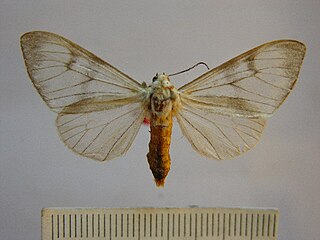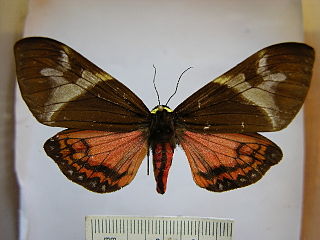
Chetone is a genus of tiger moths in the family Erebidae. The genus was erected by Jean Baptiste Boisduval in 1870.

Dysschema amphissum is a moth of the family Erebidae first described by Carl Geyer in 1832. It is found in south-eastern Brazil, ranging from southern Minas Gerais and Rio de Janeiro, south to Rio Grande do Sul.

Dysschema arema is a moth of the family Erebidae first described by Jean Baptiste Boisduval in 1870. It is found in Nicaragua, Venezuela, Peru, Brazil and Ecuador.

Dysschema boisduvalii is a moth of the family Erebidae first described by Jan van der Hoeven in 1840. It is found in Paraguay, Colombia, Brazil and Argentina.

Dysschema eurocilia is a moth of the family Erebidae first described by Pieter Cramer in 1777. It is a common species throughout tropical America, where it has been recorded from the Antilles, Central America and South America.
Dysschema hilarum is a moth of the family Erebidae first described by Weymer in 1895. It is found in Brazil.

Dysschema leda is a moth of the family Erebidae first described by Herbert Druce in 1884. It is found in Costa Rica.
Dysschema forbesi is a moth of the family Erebidae first described by Herbert Druce in 1907. It is found in Brazil.
Dysschema luctuosum is a moth of the family Erebidae first described by Paul Dognin in 1919. It is found along the south-eastern coast of Brazil, from Rio de Janeiro to Santa Catarina.

Dysschema lygdamis is a moth of the family Erebidae first described by Herbert Druce in 1884. It seems restricted to the mountains of Costa Rica and Panama.
Dysschema pictum is a moth of the family Erebidae first described by Félix Édouard Guérin-Méneville in 1844. It is found in Brazil.
Dysschema subapicalis is a moth of the family Erebidae first described by Francis Walker in 1854. It is restricted to the Atlantic forests of south-eastern Brazil.

Dysschema thyridinum is a moth of the family Erebidae first described by Arthur Gardiner Butler in 1871. It is found in Ecuador and Peru.
Dysschema viuda is a moth of the family Erebidae first described by William Schaus in 1910. It is found from Costa Rica to Ecuador.
Dysschema innominatum is a moth of the family Erebidae first described by Vitor Osmar Becker in 2013. It is restricted to southern Brazil, ranging from northern Rio Grande do Sul, to the mountains of Rio de Janeiro.
Dysschema minor is a moth of the family Erebidae first described by Vitor Osmar Becker in 2013. It is found in Mexico.

Hypocrita celina is a moth of the family Erebidae first described by Jean Baptiste Boisduval in 1870. It is found in Guatemala.
Pseudophaloe ninonia is a moth of the family Erebidae first described by Herbert Druce in 1884. It is found in Panama and Costa Rica.
Pseudophaloe schausii is a moth of the family Erebidae first described by Henry Edwards in 1884. It is found in Mexico and Guatemala.
Pseudophaloe promiscua is a moth of the family Erebidae first described by Vitor Osmar Becker and Espinosa in 2013. It is found in Costa Rica.








